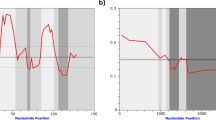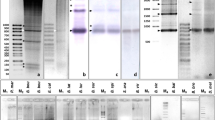Abstract
MANY eukaryotic DNAs can be resolved into two or more components by centrifugation to equilibrium in neutral CsCl1,2, the minor components being called satellite DNAs. In addition to CsCl satellites, minor portions of the genome have been resolved from the main DNA band by differential binding with Ag+ or Hg2+ ions, followed by centrifugation in Cs2SO4.
This is a preview of subscription content, access via your institution
Access options
Subscribe to this journal
Receive 51 print issues and online access
$199.00 per year
only $3.90 per issue
Buy this article
- Purchase on Springer Link
- Instant access to full article PDF
Prices may be subject to local taxes which are calculated during checkout
Similar content being viewed by others
References
Arrighi, F. E., Mandell, M., Bergendahl, J., and Hsu, T. C., Biochem. Genet., 4, 367–376 (1970).
Ingle, J., Pearson, G. G., and Sinclair, J., Nature new Biol, 242, 193–197 (1973).
Jones, K. W., Nature, 255, 912–915 (1970).
Pardue, M. L., and Gall, J. G., Science, 168, 1356–1358 (1970).
Jones, K. W., and Robertson, F. W., Chromosoma, 31, 331–345 (1970).
Hennig, W., Hennig, I., and Stein, H., Chromosoma, 32, 31–63 (1970).
Eckhardt, R. A., and Gall, J. G., Chromosoma, 32, 407–427 (1971).
Jones, K. W., Prosser, J., Corneo, G., and Ginelli, E., Chromosoma, 42, 445–451 (1973).
Ingle, J., Timmis, J. N., and Sinclair, J., Pl. Physiol., Lancaster, 55, 496–501 (1975).
La Cour, L. F., Heredity, 5, 37–50 (1951).
Sinclair, J., Wells, R., Deumling, B., and Ingle, J., Biochem. J., 149, 31–38 (1975).
Baumann, T. W., Expl Cell Res., 64, 323–330 (1971).
Pearson, G. G., Timmis, J. N., and Ingle, J., Chromosoma, 45, 281–294 (1974).
Fox, D. P., Chromosoma, 33, 183–195 (1971).
Dyer, A. F., Cytologia, 29, 155–170 (1964).
Schweizer, D., Chromosoma, 40, 307–320 (1973).
Caspersson, T., Zech, L., Modest, E. J., Foley, G. E., Wagh, U., and Simonsson, E., Expl Cell Res., 58, 128–140 (1969).
Walker, P. M. B., Nature, 229, 306–308 (1971).
Wells, R., and Ingle, J., Pl. Physiol., Lancaster, 46, 178–179 (1970).
Jones, K. W., in New technique in biophysics and cell biology, 1 (edit, by Pain, H. R., and Smith, B. J.), 29–66 (Wiley, New York and London, 1973).
Author information
Authors and Affiliations
Rights and permissions
About this article
Cite this article
TIMMIS, J., DEUMLING, B. & INGLE, J. Localisation of satellite DNA sequences in nuclei and chromosomes of two plants. Nature 257, 152–155 (1975). https://doi.org/10.1038/257152a0
Received:
Accepted:
Issue Date:
DOI: https://doi.org/10.1038/257152a0
This article is cited by
-
Comparative karyotype analysis ofCeratozamia mexicana andMicrocycas calocoma (Zamiaceae) using fluorochrome banding (CMA/DAPI) and fluorescence in situ hybridization of ribosomal DNA
Plant Systematics and Evolution (1998)
-
In situ hybridization to metaphase chromosomes in six species ofPhaseolus andVigna using ribosomal DNA as the probe
Journal of Plant Research (1994)
-
Conservation of a highly repeated DNA family of Aedes albopictus among mosquito genomes (Diptera: Culicidae)
Theoretical and Applied Genetics (1992)
-
Changes in DNA content and chromosomal size during cell culture and plant regeneration of Scilla siberica: selective chromatin diminution in response to environmental conditions
Chromosoma (1989)
-
Characterization and localization of cryptic satellite DNAs in barley (Hordeum vulgare)
Theoretical and Applied Genetics (1986)
Comments
By submitting a comment you agree to abide by our Terms and Community Guidelines. If you find something abusive or that does not comply with our terms or guidelines please flag it as inappropriate.



